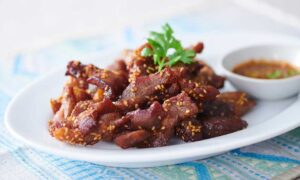Laos Food
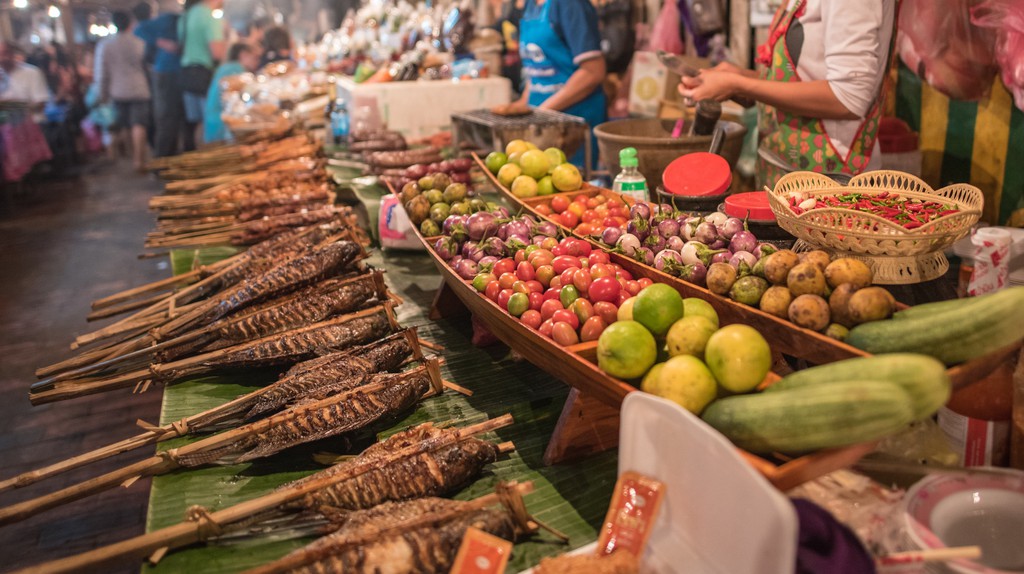
Laos Food
In Laos, food is the most important activity throughout the day. In the local language, it is quite common for people to greet each other by immediately asking, “Have you eaten food?” (“Kin khao laeo bor?”). Food is often the topic of many conversations, especially when eating and sharing dishes between friends and family. Additionally, Lao people take great passion in sharing traditional dishes with curious travelers.
Lao people were originally migrants from Southern China, composing of many different ethnic groups with distinct languages and cultures. As they moved further South, they brought their traditions along with them. Due to historical Lao migration from the Lao PDR into Thailand and neighbouring countries, Lao cuisine has a much broader recognition in the world. According to Arne Kislenko, there are more ethnic Lao living in Northern Thailand than Lao itself, leading to certain Lao dishes being found far beyond the borders of the Lao PDR. In fact, much of the food in Thailand that is called Isan is traditionally Lao rather than Thai. However, we believe that the best way to try Lao food is by exploring the diversity of cuisines found inside the borders of Laos.
Landlocked, mountainous in the north and bordered by the Mekong River on its western border with Thailand, the land and waters of Laos yield fresh dishes that vary wildly across regions and seasons. Water buffalo, wild boar, and river fish—the Lao peoples’ main sources of protein—betray close access to rice fields, jungles, and rivers.
While Lao food bears some resemblance to Thai cuisine, the differences are deeper than they appear at first glance. Unlike Thais, the Lao also cook with dill and mint, with a preference for fresh greens.
The Lao disdain sweet food, preferring bitter and herbal flavors in their meals. And the Lao predilection for eating with their hands dictates the form and temperature of their foods (the Lao never serve food piping-hot!).
Key ingredients in Lao cuisine
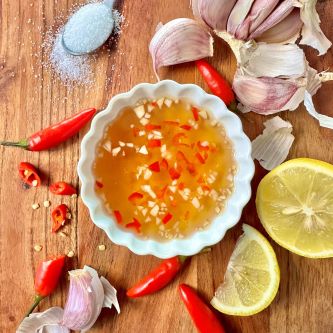
Much of the local cuisine in Laos is from foraged vegetables like bamboo and mushrooms.
Eating customs
The traditional manner of eating was communal, with diners sitting on a reed mat on the wooden floor around a raised platform woven out of rattan called a ka toke.
Dishes are arranged on the ka toke, which is of a standard size. Where there are many diners, multiple ka tokes will be prepared. Each ka toke will have one or more baskets of sticky rice, which is shared by all the diners at the ka toke.
In recent times, eating at a ka toke is the exception rather than the rule. The custom is maintained, however, at temples, where each monk is served his meal on a ka toke.
Once food is placed on the ka toke it becomes a pha kao. In modern homes, the term for preparing the table for a meal is still taeng pha kao, or prepare the phah kao.
Traditionally, spoons were used only for soups and white rice, and chopsticks (ໄມ້ທູ່,mai thu) were used only for noodles. Most food was handled by hand. The reason this custom evolved is probably due to the fact that sticky rice can only be easily handled by hand.
Lao meals typically consist of a soup dish, a grilled dish, a sauce, greens, and a stew or mixed dish (koy or laap).
The greens are usually fresh raw greens, herbs and other vegetables, though depending on the dish they accompany, they could also be steamed or more typically, parboiled.
Dishes are not eaten in sequence; the soup is sipped throughout the meal. Beverages, including water, are not typically a part of the meal.
When guests are present, the meal is always a feast, with food made in quantities sufficient for twice the number of diners. For a host, not having enough food for guests would be humiliating.
The custom is to close the rice basket, when one is finished eating.
Tradition Dishes
STICKY RICE (KHAO NIAW)
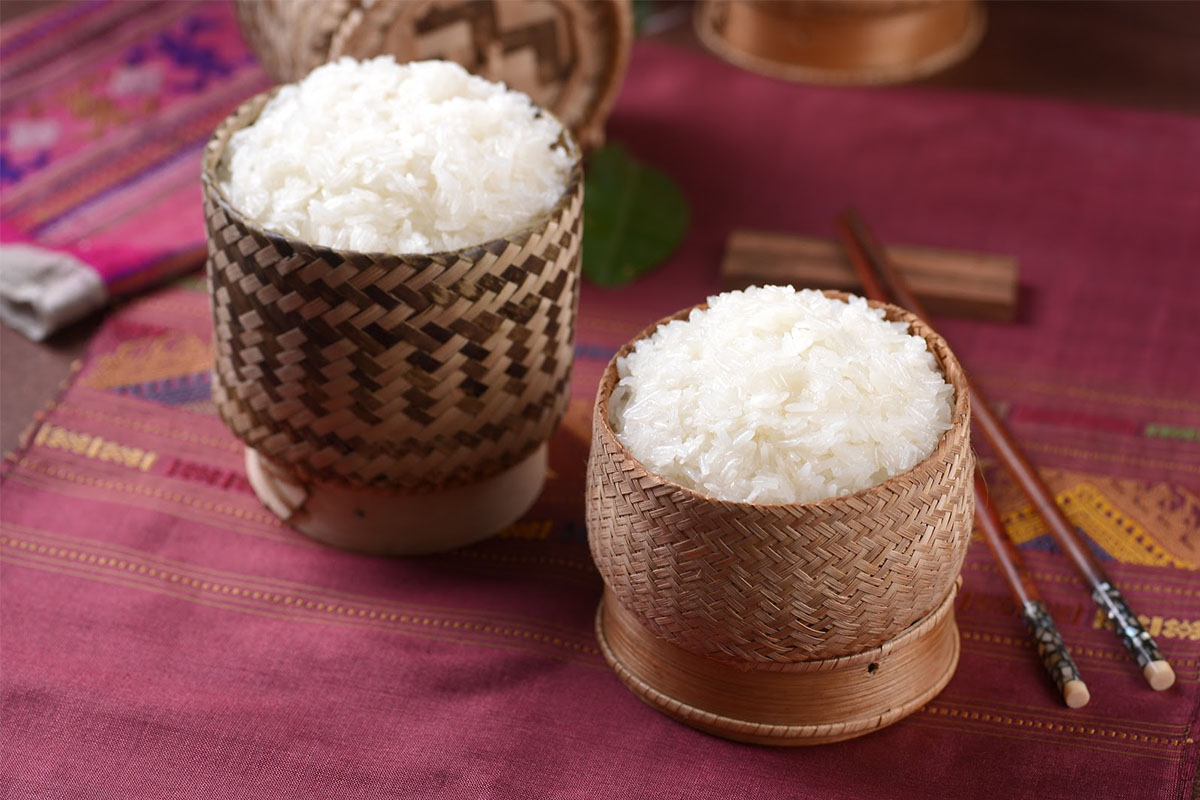
Khao niao, meaning sticky rice, is immensely popular in Laos and Northern Thailand as part of the everyday food combinations. Making the dish involves letting the rice soak in water overnight, then steaming it over a charcoal fire the next morning and putting it in little baskets after it cools down. It is eaten by hand without utensils, either by itself or as a part of a more substantial meal.
MINCED MEAT SALAD (Larb Moo)
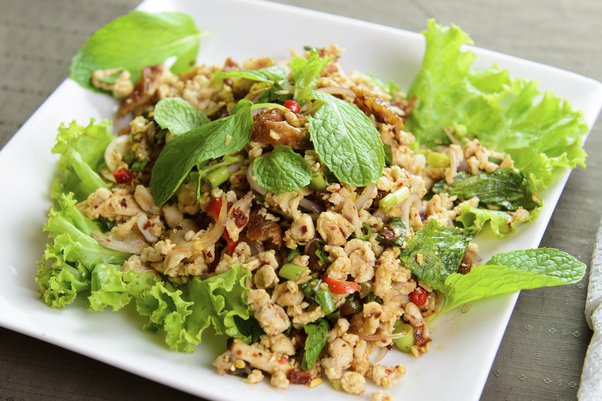
Laarb is the quintessential Laotian dish, often made with raw meat or fish.
GREEN PAPAYA SALAD (TAM MAK HOONG)
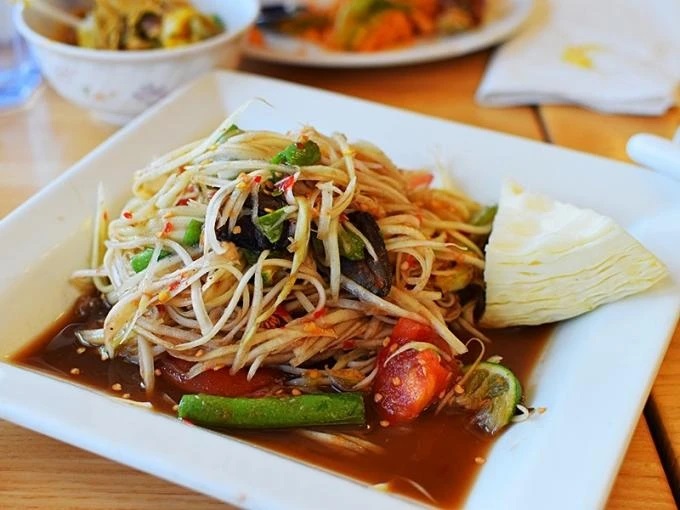
Green papaya salad is claimed as an innovation of the Lao people, which was introduced to central Thailand and the rest of the world by the Lao/Isan migrants moving to Bangkok to seek work.
The main ingredients are thin and crunchy papaya strips, which can be complemented with a variety of other vegetables such as long beans or green mangoes.
The salad is often topped with preserved or fresh crab meat, peanuts, or dried shrimps. Besides green papaya, the crucial element is a slightly sweet and spicy sauce that is generously poured over the salad. It employs classic Thai ingredients such as spicy chilis, garlic, lime juice, palm sugar, roasted ground peanuts, and tomatoes, all combined and ground into a paste.
The sauce can also appear in many other combinations, and can greatly vary in sweetness and spiciness. Numerous restaurants and street stalls allow the customers to choose the variety which they prefer and to adjust the ingredients to their preference.
STEAMED FISH (MOK PA)

BAGUETTE PATÉ (KHAO JII PATÉ)
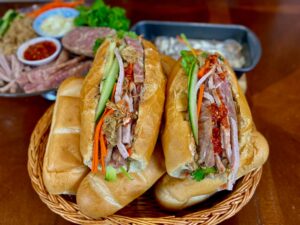
It is a famous street food in Laos. This kind of baguette is split in half and filled with lettuce, sliced tomatoes, carrot, onion and optional cheese, moo yor (pork lunchmeat), chopped ham and topped with pâté or chili sauce.
It is great to taste Khao Jee sandwich in the morning with a cup of strong filtered coffee.
WET NOODLES (KHAO PIAK SEN)
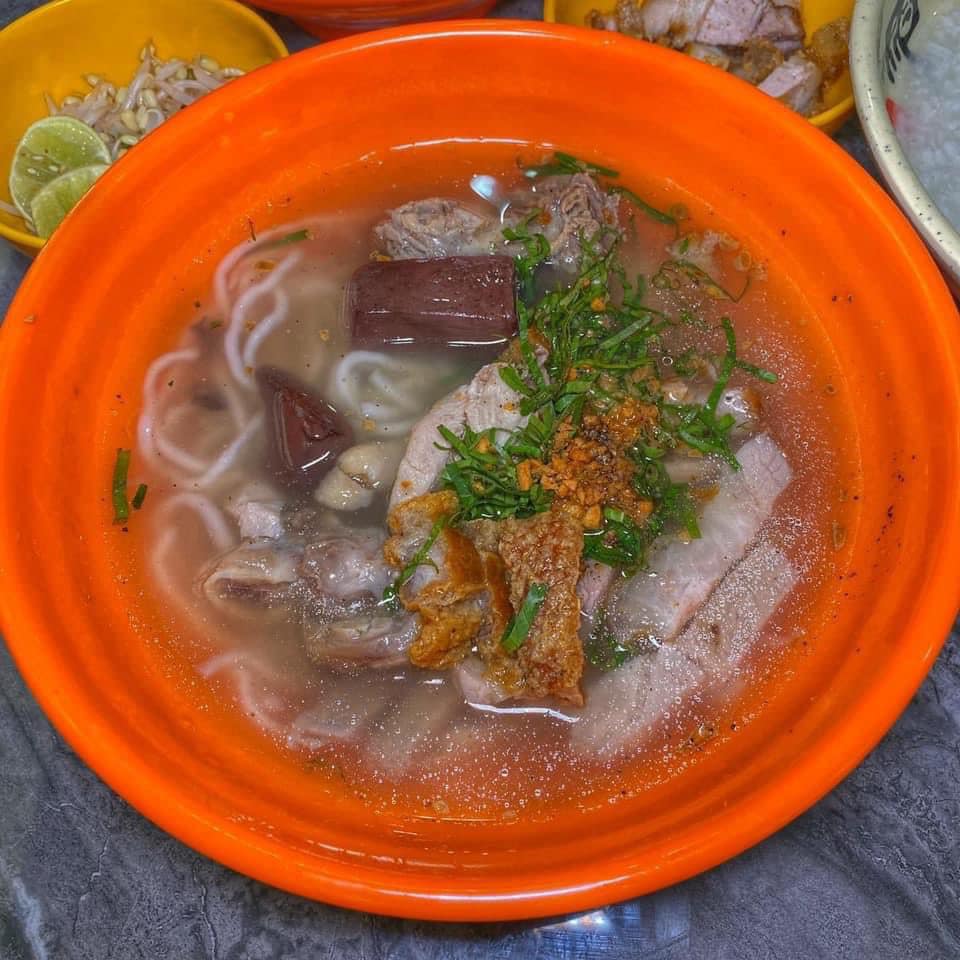
Khao piak sén is a rice noodle soup that is a part of traditional Laotian cuisine. It literally translates to wet rice strands. It is a common comfort food that’s great for a cold day.
The broth for Khao piak sen is usually made from chicken. The broth is simmered with galangal, lemongrass, and kaffir lime leaves. In addition, some also simmer the broth with garlic cooked in oil.
The noodles in Khao piak sen are chewy fresh noodles that add a lot of starch to the overall dish. The noodles are made of rice flour, tapioca starch, and water. The noodles cook directly in the broth, releasing starches that give khao piak sen its distinct consistency.
When served, the noodle soup is garnished with shredded chicken, sliced green onions, chopped cilantro, cabbage, fried garlic, fried shallots, lime, fried garlic chili and/or fish sauce. Bean sprouts are sometimes added.
CRISPY RICE SALAD (NAEM KHAO TOD)
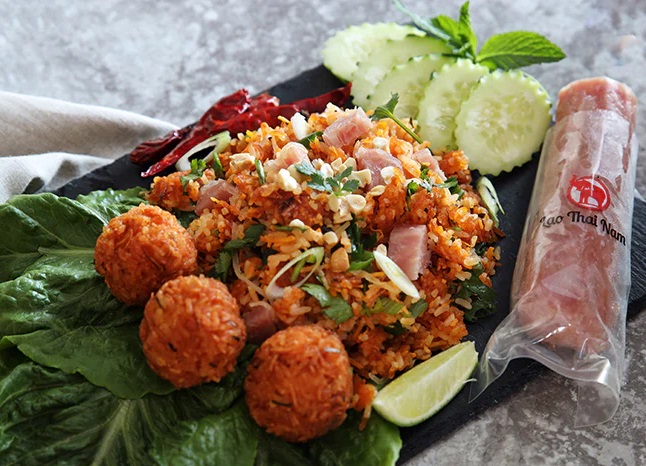
LAO SAUSAGES (SAI UAH, SAI GOK)
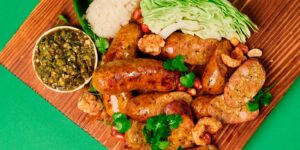
Lao sausages are an herb-infused meat that are unlike any other sausage you have ever enjoyed before. These pork sausages are mixed with lemongrass, galangal, kaffir leaves, shallots, cilantro, chili, and fish sauce. Sausages are essential to many dishes, and it must be eaten with sticky rice.
NOODLE SOUP (PHOR)
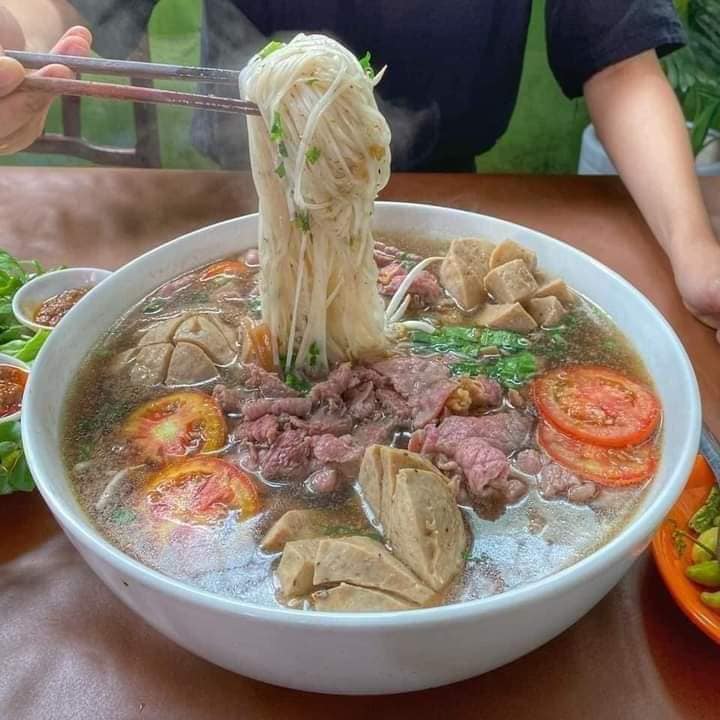
Noodle soup is made with a beef broth rich with ginger, fish sauce, star anise, and onions. Into that go rice noodles, sirloin, scallions, bean sprouts.
Or Lam
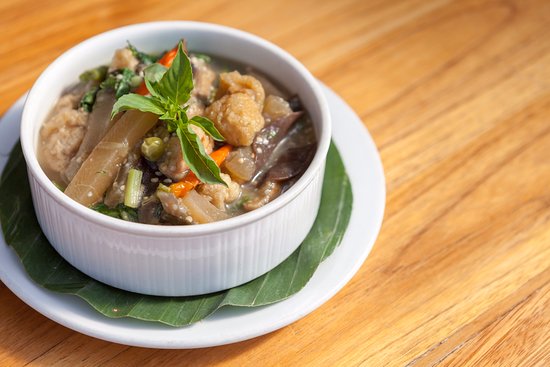
This Laotian dish is popular in the mountainous region of Luang Prabang, the magical city in the northern part of Central Laos.
It is a complex and mildly spicy stew, multi layered with flavors and textures, creating a unique, nutritious and delicious dish. It possesses a subtle harmony within a charismatic orchestra of flavors and textures; the taste of meat coupled with the sweetness of vegetables, opposing the bitterness of the greens and willingly surrendering to the aroma of fresh dill and fragrant lemon basil… but it’s not all yet….
The stew’s base is a mild peppery broth prepared by slowly simmering lemongrass, chili and pepper wood (sakhaan) with the preferred meat, depends on the type of meat, it can be used fresh, dried, salted or grilled.
The meat of choice is usually dried and salted buffalo meat, but really, any meat can be used – game meat (usually roasted first), quails, small jungle birds, deer, beef and even the common chicken will make a great Or Lam.
Tam Lao
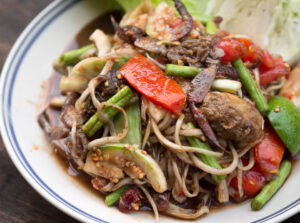
Tam Lao is a version of spicy young papaya salad that has black crab, dried shrimp, tomatoes and the pungent Lao fish sauce, padek. This dish is served spicy with a generous portion of dried red chilies. The funky spicy flavour is cut with a bit of sugar and citrus.
Jaew Bong (Hot Pepper Dip)
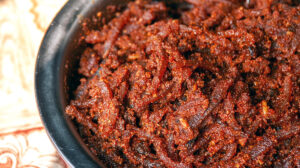
A favorite of both Lao natives and visitors alike, jaew bong is a spicy variety of a traditional dipping sauce (jaew) that accompanies most Lao dishes.
Jaew bong is a sticky mass of fish sauce, palm sugar, dried chili, garlic, shallots, and tamarind. The mixture is fried in oil, then cooked at a low temperature to meld the flavors and thicken it up, resulting in a funky, slightly sweet spread with a low-intensity spicy burn.
Muu Haeng (Sun-Dried Pork) and Siin Haeng (Sun-Dried Beef)
Muu Haeng or Siin Haeng are dried foods made from thin slices of pork or beef are marinated and then sun-dried. The marinade is a mixture of fish sauce, black soy sauce, oyster sauce, and chopped cilantro, garlic, galangal, lemongrass, and ginger.
Ping Hua Jai Kai (Grilled Chicken Hearts)
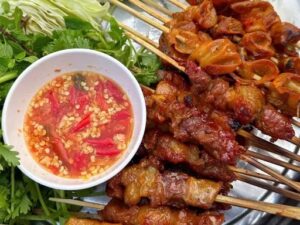
Piing hua jai kai are a snack commonly found in street markets, threaded on a stick along with other tasty bits of offal. The chicken hearts, which are about the size of a quarter, get trimmed of fat and butterflied down the center before being marinated overnight in a host of ingredients, including ground lemongrass, galangal, ginger, garlic, fish sauce, soy sauce, oyster sauce, and palm sugar.
Coconut Sweets ( Khao Nom Kok)
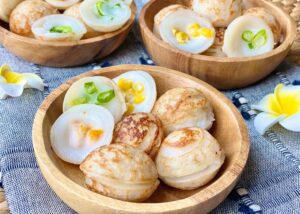
One of the Laos dessert is the most are small round coconut rice pancakes cooked in a mold griddle. Called Khanom Nom Kok, these small pancakes are slightly chewy, made with rice and coconut and with a mild sweet flavor. There are easy to share and eat as a snack.
Lao dessert (Kanom Khai Nok Khata)
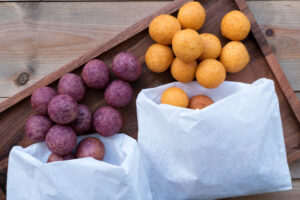
Kanom Kai Hong

Khao Thom Pad
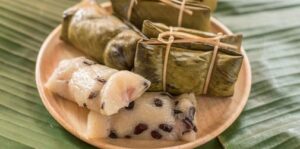
Khao thom pad is a classic Lao dessert consisting of a coconut sweet rice with banana wrapped in a parcel and steamed in banana leaves.
Salee Haw Kaab
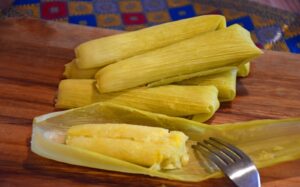
Drinks in Laos

Laos has all the international favorites available when it comes to drinks, but the local juices, including sugar cane juice and coconut milk are among the more authentic locals. Tea is also very popular in Laos and it is generally served with sweetened condensed milk over ice. Coffee, milk, and soft drinks are also readily available in Laos.
If you want some alcohol in Laos try the local beers, starting with “Beerlao,” which is highly regarding by locals and foreigners alike. For a more authentic local taste, try the lao hai, which is similar to sake or lao lao, which is similar to whiskey. Lao lao is a popular drink in Laos and well patronized because of its local origin. Moreover, Lao Lao is very cheap and easily affordable by all class of people. This implies Lao Lao is a poor man’s drink in Laos. Lao hai is the Laotian wine and drunk by all. This Laotian drink is made of rice. Since the rice wine is brewed in an earthen pot (hai), it is known as Lao Hai. Other whiskeys also exist as whiskey is oddly popular in Laos, but still takes a back seat to beer.
The tap water in Laos should not be consumed. Be sure to also avoid anything with ice as it may have been made from the tap water. Salads and fruits could have also been washed in the tap water so be careful with those foods as well.
Som moo
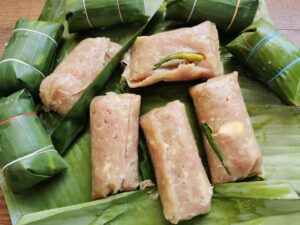
Som moo, literally “sour pork”, is a type of fermented or soured Laotian pork sausage that is a very popular staple. It is made from raw pork consisting of rump and it typically is made with pork skin.
In Laos, it is sometimes wrapped in star gooseberry leaves (“bai ma yom”) or banana leaves for additional flavoring. Som moo may be eaten raw or cooked using common methods such as grilling. It is similar to the Vietnamese nem or nem chua and Thai naem.
Khanom Mo Kaeng
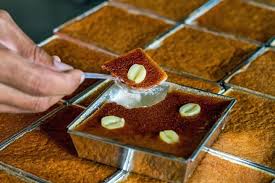
Khanom mo keang is a traditional Thai dessert that is bit of a cross between custard, a flan, and a cake. It is very sweet and soft, and is so good that you can easily eat multiple portions in one sitting!
Grilled fish
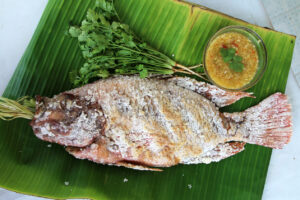
One of the specialties that tourists cannot ignore is the seafood that is the product of the river. Grilled fish is mainly the fish of the Mekong River with a simple processing, but always considered the best dish among the dishes. Fish to make grilled fish is about a half of kg, must be fresh, usually the fish from rivers and streams like carp and amur.
After initial processing, people clean, remove the intestines of fish, then add salt in about 10-15 minutes, then grill fish to the fresh bamboo bar to grill directly on charcoal. The fish is cooked and fragrant, people use claw stripe along the fish, the fish is removed intact, not broken. Since the fish was salted before baking, so when cooked, baked fish skin is not covered with a layer of salt, fish does not stick to the skin and fish is very fragrant. Grilled fish served with vegetables and can be added with fish sauce or salt. Beside the vegetables, you can eat fish with grilled rice, sticky rice to feel the full sweetness of fish, the piquancy of chili, and the aroma of spices.

